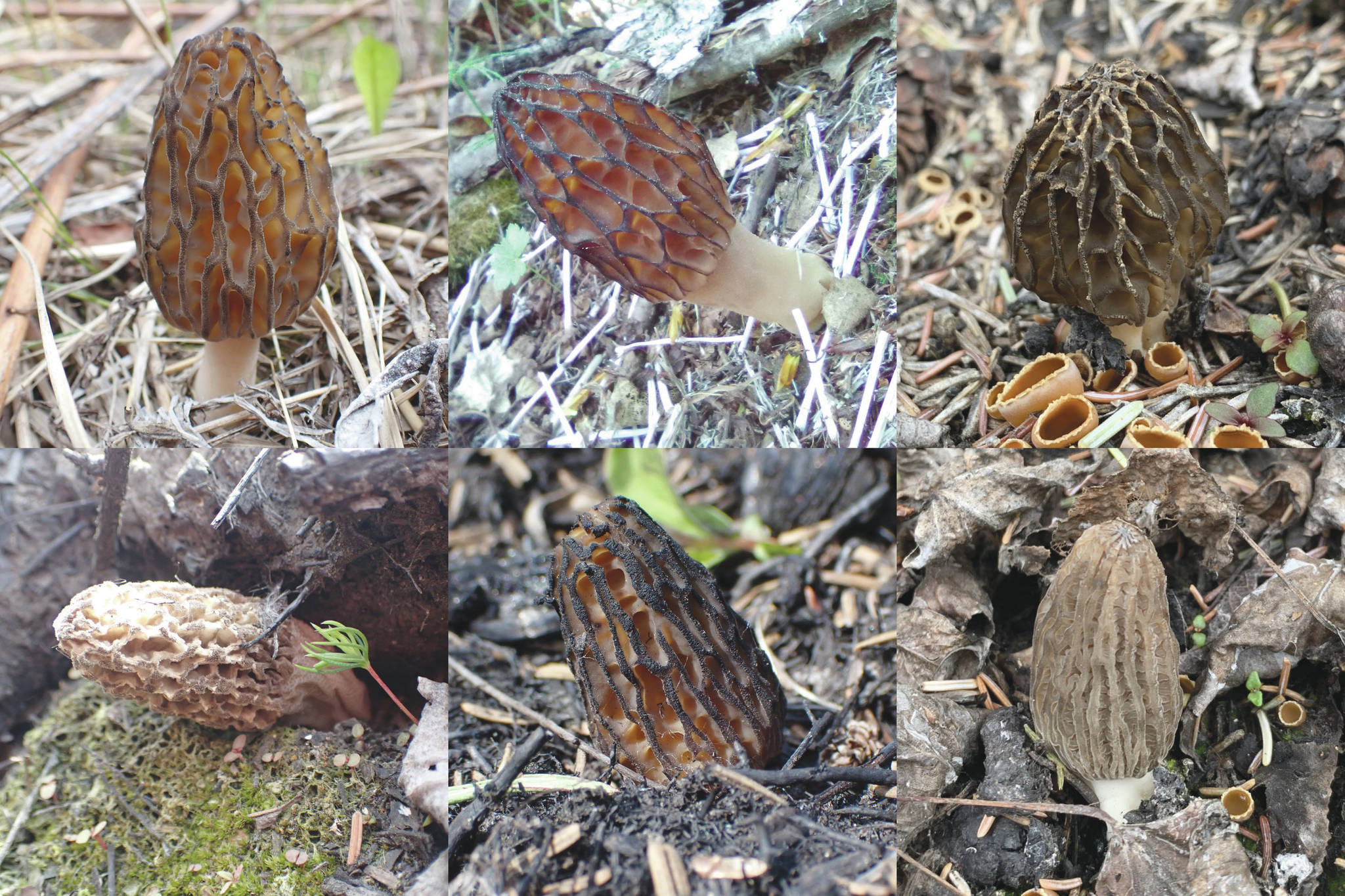Years ago, a co-worker shared with me a place where morels appeared at the bases of cottonwood trees. I have found them at that same spot at about the same time every year. These morels also show up under cottonwoods at other places, including on my family’s land in Kasilof.
Tromping through the woods with my kids seeking out these first morels of spring is now an annual tradition.
Having read that there are many species of morels, each special in its way, I have long wanted to know which one was growing on my property. I also wanted to be able to tell people what kinds of morels they were harvesting from within burns like the recent Swan Lake Fire burn.
You might ask the use of identifying morel species when they are all good to eat. We already know that morels appear post-fire and some morels can be found in unburned forests. This is enough knowledge to harvest and enjoy morels. My response is that being able to recognize things changes your perspective.
I think that gathering and eating morels might be like harvesting and putting up salmon. Our six Pacific salmon species (kings, silvers, reds, chums, pinks and rainbow trout) all look similar (at least when fresh and bright), but we know they are not the same.
They swim up the rivers at different times and spawn in different places. We change our tackle and tactics for each kind of salmon.
When it comes to uses, most Alaskans I have met recognize the distinct qualities of our Alaska salmon species when it comes to preserving, cooking and eating these fish. This is why, when I consider choosing “salmon” from the menu at a restaurant, I ask, “What kind?”
Identifying morels is difficult, even for specialists, but DNA sequencing methods have become increasingly useful for identifying morels and other fungi.
Fungal sequencing methods have also become more widely available, in part through the Fungal Diversity Survey (FunDiS, https://fundis.org/), a citizen science initiative to discover the diversity of fungi in North America.
Last year, while refuge staff surveyed non-native plants, measured burn severity and harvested morels for our own use, we opportunistically picked up morels from various places.
We dried them, cataloged them and sent tissue samples out for DNA sequencing through FunDiS. Kate Mohatt from Chugach National Forest also collected morels from the area and submitted samples for sequencing.
We found more diversity than I expected: six species of morels from the central Kenai Peninsula!
All the morels we collected from under cottonwoods at three locations turned out to be a species whose name means “beautiful morel.” This one is widespread across Europe and Asia, where it has been found in unburned areas growing under pines, cedars, junipers, birches, ashes and poplars.
Because the beautiful morel pops up under a wide variety of trees in other places, we should be on the lookout for them under aspens, birches and willows in addition to cottonwoods.
Morels from the edge of a gravel pull-off beside Kalifornsky Beach Road were identified as Norwegian morels. Another species of unburned areas that is widespread in Europe and North America, the Norwegian morel typically grows in sandy, grassy and disturbed areas along forest edges.
I have seen what I think are the same morels coming up at this same pull-off over multiple years, so they apparently do not need the soil to be disturbed repeatedly in order for them to persist.
The remaining four kinds of morels that we found were all post-fire species.
The gray morel, the only morel we had previously identified from the Kenai, was common in the Swan Lake Fire burn, mainly in black spruce forest and mixed forest that had been so severely burned that the upper, organic soil layers had been completely consumed.
Gray morels came up in July, later than the other three fire-associated morels. The gray morel is known only from Western North America.
The excellent morel and the exuberant morel were also common within the Swan Lake Fire burn. These two post-fire species are widespread in Europe and North America.
Excellent morels were found in places not dominated by conifers and where the ground had been less severely burned, leaving some of the upper soil layers intact.
Exuberant morels popped up in severely burned forest in places similar to where gray morels were found. They just appeared earlier in the season than the grays.
The sixth morel we collected was a species whose name literally means “sixth.” It was the sixth member of a group of related morels known as black morels.
We found the sixth black morel in a few different kinds of places in the fire scar that had been moderately to severely burned. This species is known from North America and Asia.
Now that we know of these six types of morels in our area and we have learned something about where and when they show up, we can better refine our strategies for searching for them. Also, I would not be surprised if, like the salmon, we eventually learn that these different morels vary in their qualities on the table.
While I expect that few people will bother with the trouble of identifying morels, I hope that it is helpful to know that multiple kinds of morels are out there. As for myself, I plan to look for beautiful morels and Norwegian morels in unburned forest while the crowds return to the Swan Lake Fire burn in spring 2021.
Matt Bowser serves as Fish and Wildlife Biologist at Kenai National Wildlife Refuge. Kate Mohatt, an Ecologist at Chugach National Forest, contributed data on morels from the Swan Lake Fire. Doug Gordon provided the salmon analogy. Find more Refuge Notebook articles (1999–present) at https://www.fws.gov/refuge/Kenai/community/refuge_notebook.html.
By MATT BOWSER
Kenai National Wildlife Refuge

